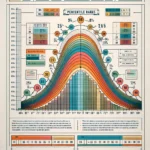Percentile Ranks in Cognitive Testing: Understanding Your Results
Percentile ranks are an essential part of interpreting cognitive testing results, providing a clear indication of an individual’s performance relative to a reference group. Cognitive tests often measure abilities such as reasoning, memory, attention, and language skills. Understanding percentile ranks can help individuals, educators, and clinicians make informed decisions based on the test outcomes.
What is a Percentile Rank?
A percentile rank is a statistical value that represents the position of an individual’s test score in a pre-established norm group. It indicates the percentage of people in the reference group who scored the same as or lower than the test-taker. For example, if a person is at the 75th percentile, they have performed better than 75% of the individuals in the reference group.
Calculation and Interpretation
Percentile ranks are calculated using the scores from a normative sample, which is a group of individuals who are representative of the population for which the test is intended. Test developers compile the scores from this group to form a distribution, often a bell curve or normal distribution, against which individual scores are compared.
In cognitive testing, percentiles assist in identifying an individual’s cognitive strengths and weaknesses. A higher percentile rank typically indicates a stronger ability in the tested domain, while a lower percentile rank may suggest a potential area for improvement or further assessment.
Relevance in Different Contexts
Educational Assessment: In educational settings, percentile ranks are utilized to monitor students’ progress and compare their cognitive abilities with peers at a similar educational level.
Clinical Evaluation: Healthcare professionals use percentile ranks for diagnosing learning disabilities, attention deficit hyperactivity disorder (ADHD), and other cognitive-related disorders, providing critical information for treatment plans.
Research and Development: Researchers employ percentile ranks to analyze cognitive abilities across different populations and devise new cognitive assessment tools.
Caveats and Considerations
While percentile ranks are beneficial for interpretation, it’s important to consider the limitations. Scores can be influenced by various factors, such as the individual’s test-taking skills, motivation, and environmental conditions during testing.
Percentile ranks should also be used in conjunction with other evaluative measures for a more comprehensive understanding of cognitive abilities. Furthermore, the reference group’s characteristics (e.g., age, education) are crucial for accurate comparisons, as they must align with the individual’s demographic profile.
In summary, percentile ranks are an invaluable tool in cognitive testing, providing context and meaning to raw scores. When understood and used correctly, they contribute to a deeper comprehension of cognitive abilities, guiding educational strategies, clinical interventions, and research endeavors.

